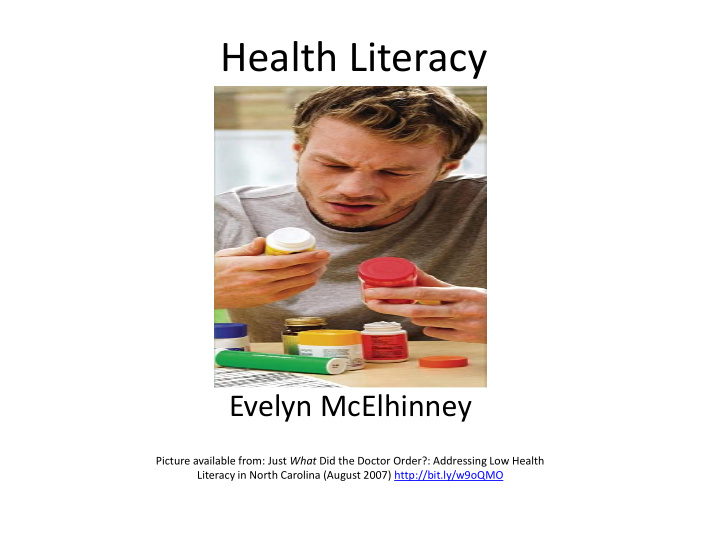



Health Literacy Evelyn McElhinney Picture available from: Just What Did the Doctor Order?: Addressing Low Health Literacy in North Carolina (August 2007) http://bit.ly/w9oQMO
Aims of Session • Introduce you to the concept of health literacy • Why it is important • What can we do to promote and increase • What is happening in Scotland
Health Literacy definitions • Many definitions – some take a very clinical functional approach – can you follow a prescribed regime (take your medication) • Others a more public health approach – can you seek out, use (act on), health information to remain healthy or change your modifiable health behaviour – (lifestyle in everyday life)
Nutbeam’s definition for World Health Organisation (WHO 1998) • “the cognitive and social skills which determine the motivation and ability of individuals to, gain access to, understand and use health information in ways which promote and maintain good health (Nutbeam 1998 p. 357)
Why is it important? Most Literature from USA sparked by Institute of Medicine report (IOM 2004) and Literacy surveys: “ 90 Million Americans can not read complex text” - ?oh maybe they can not read health information! Now worldwide aim increase HL (WHO track 2 millennium development goals)
Why is it important Linked to an increase in • Chronic illness • Reduced health knowledge • Increased hospitalisation • Lower use of screening (mammography) • Lower use of preventative programmes (influenza vaccine), • Poorer functional literacy (reading labels, health messages) • Mortality in elderly (Berkman et al. 2004, 2011), Bostock (2012)
The Scottish Survey of Adult Literacies (SSAL 2009) • 40% of the population scored in the lowest levels (1-2) of literacy and numeracy • 3.6% (one person in 28) faces serious challenges in their literacies practices • 15% in the most deprived areas • More likely to have a LTC or disability
European Health literacy survey • Almost one in two, on average 47%, has risk of limited health literacy • across eight countries but levels vary between the countries. In certain subgroups • there are higher risks, such as elderly, people with low levels of education, • people with low socio-economic status • people considering having bad health. http://bit.ly/1qM32VR
Who is affected? - Everyone but The problem of limited health literacy is greater among: Older adults Those who are poor People with limited education Minority populations Persons with limited English proficiency (LEP) Disabled Chronic conditions (not able to manage) Unemployed (US Department of Health and Human Services 2011 - SSAL 2009)
Low health Literacy shame • People with limited health literacy often report feeling a sense of shame about their skill level. • Individuals with poor literacy skills are often uncomfortable about being unable to read well, and they develop strategies to compensate. US Department of Health and Human Services 2011
Signs that a patient may have limited health literacy skills • Excuses: "I forgot my glasses." • Lots of papers folded up in purse/pocket. • Lack of follow-through with tests/appointments. • Seldom asks questions. • Questions are basic in nature. • Difficulty explaining medical concerns or how to take meds Davis et al. 2009, US Department of Health and Human Services 2011
What can we do • Whole systems approach – health, education, business, governmental • Be aware of our own communication skills • Be aware of our patients, clients needs and cultural background • Use of plain language • Use of technology (multi media, social media) • Tailored information • Use of teach back technique • It’s ok to ask Davis et al. 2009
Move away from giving information • Passive recipients Lecturing If you are young and drink a lot of alcohol on a night out. You might get into a whole heap of trouble and it is bad for your health
Social Marketing • http://www.youtube.com/watch?v=cN3CXmp6PLs
Social Media
3D Virtual Worlds/Games http://www.attackofthemutans.com/ http://slidesha.re/OvZWGF
Scotland http://www.nhsinform.co.uk/ http://www.sctt.scot.nhs.uk/
Scotland Teach- back” technique The “teach - back” technique is an effective method for ensuring that patients understand what you have told them. • It involves asking patients to explain or demonstrate what they have been told. • For example, you can say, “I want you to explain to me how you will take your medication, so I can be sure I have explained everything correctly,” or • “Please show me how you will use the asthma inhaler, so I can be sure I have given you clear instructions,” or • “When you get home your spouse will ask you what the doctor said— what will you tell your spouse?”. Adapted from : Removing barriers to better, safer care, Health literacy and patient safety: Help patients understand, Manual for clinicians, 2nd ed., Barry D. Weiss, MD, 2007 American Medical Association Foundation and American Medical Association
Your thoughts go to Padlet This link (removed) Spend the next ten minutes posting your thoughts on what you think are the challenges of increasing health literacy skills and the challenges you faced and the solutions you found when carrying out the task of creating health promotion materials
References Bostock, S., and Steptoe, A (2012) Association between low functional health literacy and mortality in older adults: longitudinal cohort study, BMJ, British Medical Journal 344 Berkman, N.D., Sheridan, S.L., Donahue, K.E., Halpern, D.J. & Crotty, K. (2011) Low Health Literacy and Health Outcomes: An Updated Systematic Review, Annals of Internal Medicine, vol. 155, no. 2, pp. 97-107. Executive Agency for Health and Consumers (2012) Final report Executive summary (D17) The European Health Literacy Project (HLS-EU) The HLS-EU Consortium Institute of Medicine (2004) A prescription to end confusion, IOM Nutbeam, D. (1998) Health promotion glossary1, Health promotion international , vol. 13, no. 4. Scottish Government (2009) The Scottish Survey of Adult Literacies, Scottish Government: Edinburgh Weiss, B (2007) Removing barriers to better, safer care, Health literacy and patient safety: Help patients understand, Manual for clinicians, 2nd ed. American Medical Association Foundation and American Medical Association
Recommend
More recommend